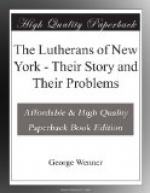Seventy years ago a great company of Christian men met in the old Luther town of Wittenberg to consider the needs of the Fatherland. It was the year of the Revolution. It was a time of political confusion and of desperate spiritual need. It was then that Wichern, in an address of impassioned eloquence, pointed the way toward the mobilization of all Christians in a campaign of spiritual service.
He was directed to prepare the program. It appeared in 1849 under the title “Die Innere Mission.”
It was a clarion call to personal service and it met with an immediate and remarkable response. The movement marked an epoch in the history of the church.
Because the Inner Mission lends itself in a peculiar way to works of charity it is often regarded as synonymous with the care of the helpless and afflicted. In this use of the term we lose sight of the larger meaning and scope of the work which has made it one of the great religious forces of the nineteenth century. It should therefore be more accurately described as that movement of the nineteenth century which, recognizing the alienation of multitudes within the church from the Christian faith and life appeals [sic] to all disciples of Christ by all means to carry the Gospel to men of all classes who have strayed away and to gather them into the communion and confession of the church. It is a mission within the church and hence bears the name of Inner Mission.
Such a call comes to us at a time when we are confronted with a problem which almost staggers the imagination and when we are offered an opportunity such as no other Protestant church enjoys.
The Problem of Statistics
The word statistics, according to the Century Dictionary, refers not merely to a collection of numbers, but it comprehends also “all those topics of inquiry which interest the statesman.” The dignity thus given to the subject is enhanced by a secondary definition which calls it “the science of human society, so far as deduced from enumerations.”
No branch of human activity can be studied in our day without the use of statistics. Statesmen and sociologists make a careful study of figures before they attempt to formulate laws or policies.
For church statistics we are chiefly dependent upon the tables of the Synodical Minutes. The original source of our information is the pastor’s report of his particular congregation. Unfortunately the value of these tables is greatly impaired by the absence of a common standard of membership.




